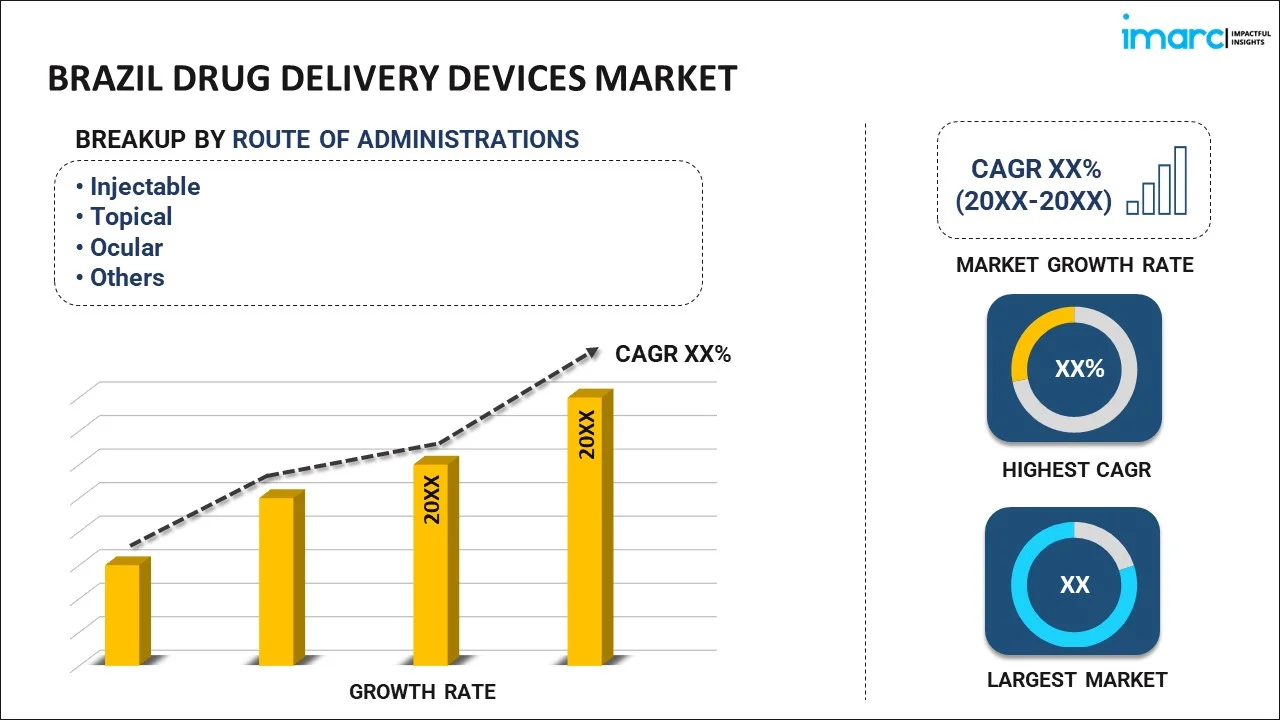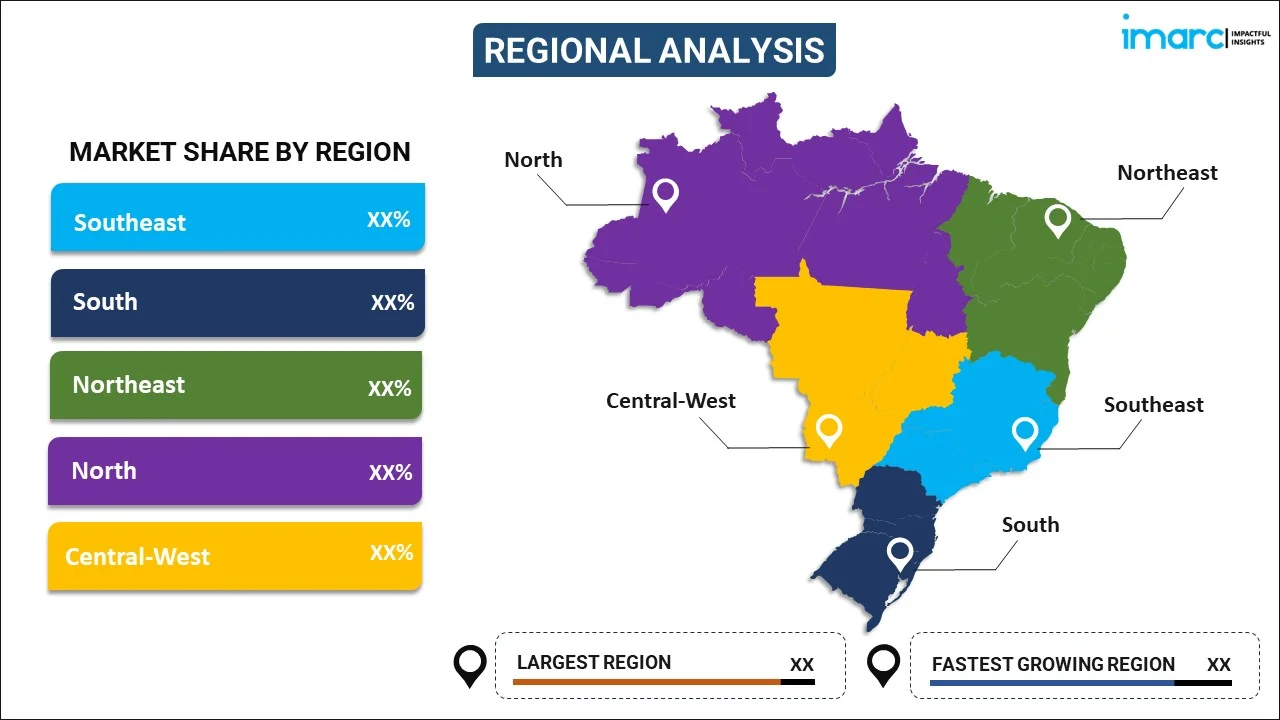
Brazil Drug Delivery Devices Market Report by Route of Administration (Injectable, Topical, Ocular, and Others), Application (Cancer, Cardiovascular, Diabetes, Infectious Diseases, and Others), End User (Hospitals, Ambulatory Surgical Centers, and Others), and Region 2025-2033
Market Overview:
Brazil drug delivery devices market size reached USD 721.2 Million in 2024. Looking forward, IMARC Group expects the market to reach USD 1,311.5 Million by 2033, exhibiting a growth rate (CAGR) of 6.95% during 2025-2033. The increasing prevalence of chronic diseases, development of biologic drugs and targeted therapies, rising shift toward patient-centric care and self-administration of medications, aging population, growing innovations in drug delivery technology, and the rising trend toward personalized medicine represent some of the key factors driving the market.
|
Report Attribute
|
Key Statistics
|
|---|---|
|
Base Year
|
2024 |
|
Forecast Years
|
2025-2033
|
|
Historical Years
|
2019-2024
|
| Market Size in 2024 | USD 721.2 Million |
| Market Forecast in 2033 | USD 1,311.5 Million |
| Market Growth Rate (2025-2033) | 6.95% |
Drug delivery devices are specialized medical instruments engineered to administer medications in a controlled, targeted, and safe manner. These devices are vital components in medical treatments as they directly influence the effectiveness of the therapeutic intervention. The primary objective of a drug delivery device is to ensure the accurate delivery of a prescribed dose of medication to the correct site within the human body over a specific time frame. In doing so, these devices contribute to achieving optimal therapeutic outcomes while minimizing the risk of adverse effects and complications. The types of drug delivery devices are diverse, ranging from simple syringes and inhalers to complex programmable pumps and implantable devices. Each type is tailored for specific routes of administration oral, inhalation, intravenous, subcutaneous, or transdermal depending on the medical condition being treated. For instance, nebulizers and metered-dose inhalers are primarily used for administering bronchodilators and anti-inflammatory medications in respiratory disorders like asthma and chronic obstructive pulmonary disease (COPD). On the other hand, insulin pens and pumps are designed for the accurate dosing and administration of insulin in diabetes management.
Brazil Drug Delivery Devices Market Trends:
The increasing prevalence of chronic diseases such as diabetes, cardiovascular disorders, and cancer necessitates more effective drug delivery methods which represents one of the key factors driving the market growth across Brazil. Drug delivery devices provide a means to manage these conditions efficiently. The development of biologic drugs and targeted therapies, which often require precise and controlled delivery, thus fueling the demand for advanced drug delivery devices. A shift towards patient-centric care and self-administration of medications is driving the demand for user-friendly and home-based drug delivery devices, which enhances patient convenience and adherence to treatment plans. The global aging population requires a higher volume of healthcare services, including drug therapies. Drug delivery devices are crucial in meeting the healthcare needs of elderly patients. Ongoing innovations in drug delivery technology, such as microneedles, inhalers, and smart devices, offer enhanced precision, safety, and ease of use, which is driving their adoption. The development of biocompatible and biodegradable materials for drug delivery devices reduces the risk of adverse reactions and improves overall device safety. The growth of telemedicine and remote patient monitoring increases the demand for connected drug delivery devices that allow healthcare professionals to monitor and adjust treatments remotely. Favorable regulatory policies and approvals for drug delivery devices enhance their adoption and market expansion, which ensures product safety and efficacy. Increasing patient awareness about drug delivery options and the benefits of using specific devices is facilitating their adoption, which is creating a positive outlook for the market across Brazil.
Brazil Drug Delivery Devices Market Segmentation:
IMARC Group provides an analysis of the key trends in each segment of the market, along with forecasts at the country level for 2025-2033. Our report has categorized the market based on route of administration, application, and end user.
Route of Administration Insights:

- Injectable
- Topical
- Ocular
- Others
The report has provided a detailed breakup and analysis of the market based on the route of administration. This includes injectable, topical, ocular, and others.
Application Insights:
- Cancer
- Cardiovascular
- Diabetes
- Infectious Diseases
- Others
The report has provided a detailed breakup and analysis of the market based on the application. This includes cancer, cardiovascular, diabetes, infectious diseases, and others.
End User Insights:
- Hospitals
- Ambulatory Surgical Centers
- Others
A detailed breakup and analysis of the market based on the end user have also been provided in the report. This includes hospitals, ambulatory surgical centers, and others.
Regional Insights:

- Southeast
- South
- Northeast
- North
- Central-West
The report has also provided a comprehensive analysis of all the major regional markets, which include Southeast, South, Northeast, North, and Central-West.
Competitive Landscape:
The market research report has also provided a comprehensive analysis of the competitive landscape in the market. Competitive analysis such as market structure, key player positioning, top winning strategies, competitive dashboard, and company evaluation quadrant has been covered in the report. Also, detailed profiles of all major companies have been provided.
Brazil Drug Delivery Devices Market Report Coverage:
| Report Features | Details |
|---|---|
| Base Year of the Analysis | 2024 |
| Historical Period | 2019-2024 |
| Forecast Period | 2025-2033 |
| Units | Million USD |
| Scope of the Report | Exploration of Historical and Forecast Trends, Industry Catalysts and Challenges, Segment-Wise Historical and Predictive Market Assessment:
|
| Route of Administrations Covered | Injectable, Topical, Ocular, Others |
| Applications Covered | Cancer, Cardiovascular, Diabetes, Infectious Diseases, Others |
| End Users Covered | Hospitals, Ambulatory Surgical Centers, Others |
| Regions Covered | Southeast, South, Northeast, North, Central-West |
| Customization Scope | 10% Free Customization |
| Post-Sale Analyst Support | 10-12 Weeks |
| Delivery Format | PDF and Excel through Email (We can also provide the editable version of the report in PPT/Word format on special request) |
Key Questions Answered in This Report:
- How has the Brazil drug delivery devices market performed so far and how will it perform in the coming years?
- What has been the impact of COVID-19 on the Brazil drug delivery devices market?
- What is the breakup of the Brazil drug delivery devices market on the basis of route of administration?
- What is the breakup of the Brazil drug delivery devices market on the basis of application?
- What is the breakup of the Brazil drug delivery devices market on the basis of end user?
- What are the various stages in the value chain of the Brazil drug delivery devices market?
- What are the key driving factors and challenges in the Brazil drug delivery devices?
- What is the structure of the Brazil drug delivery devices market and who are the key players?
- What is the degree of competition in the Brazil drug delivery devices market?
Key Benefits for Stakeholders:
- IMARC’s industry report offers a comprehensive quantitative analysis of various market segments, historical and current market trends, market forecasts, and dynamics of the Brazil drug delivery devices market from 2019-2033.
- The research report provides the latest information on the market drivers, challenges, and opportunities in the Brazil drug delivery devices market.
- Porter's five forces analysis assist stakeholders in assessing the impact of new entrants, competitive rivalry, supplier power, buyer power, and the threat of substitution. It helps stakeholders to analyze the level of competition within the Brazil drug delivery devices industry and its attractiveness.
- Competitive landscape allows stakeholders to understand their competitive environment and provides an insight into the current positions of key players in the market.
Need more help?
- Speak to our experienced analysts for insights on the current market scenarios.
- Include additional segments and countries to customize the report as per your requirement.
- Gain an unparalleled competitive advantage in your domain by understanding how to utilize the report and positively impacting your operations and revenue.
- For further assistance, please connect with our analysts.
 Request Customization
Request Customization
 Speak to an Analyst
Speak to an Analyst
 Request Brochure
Request Brochure
 Inquire Before Buying
Inquire Before Buying




.webp)




.webp)












